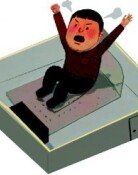Is South Korea prepared for ‘that day’?
Is South Korea prepared for ‘that day’?
Posted October. 11, 2017 07:36,
Updated October. 11, 2017 09:01
At this moment, the two carrier strike groups of nuclear-powered aircraft carriers, the symbol of the United States’ military power, are approaching the shores near the Korean Peninsula. One is the Carrier Strike Group of Nimitz-class USS Theodore Roosevelt, which departed from its home port in San Diego on Friday and is scheduled to arrive at the end of October, and the Carrier Strike Group of USS Ronald Reagan, which holds Yokosuka, Japan, as its home port. The military strength of each of the two carrier strike groups is as powerful as the entire military strength of navy and air force of a small country. Some experts even interpret that this is a preparation for a pinpoint strike on North Korea, surrounding North Korea’s nuclear weapons.
During the Chuseok holidays, Korean people were most curious about the topic of “is war going to break out?” Sixty-seven years ago, the Korean War began with a North Korean invasion of the South, under the support of Russia. But when the second war breaks out on the Korean Peninsula, it can be caused by North Korea’s rash behavior of trying to equip not only intercontinental ballistic missile (ICBM), but also hydracid warhead, and great military power the United States that aims at punishing the communist state for provocations. War should never take place. But it is necessary to be prepared for any kind of unfortunate events. Are the people, the government and the military of South Korea ready to respond to a war?
When war breaks out, the president will immediately execute an emergency martial law. The martial law commander, appointed by the president, will be in charge of administration and jurisdiction of the entire country as well. The martial law was executed for political reasons when Korea was under dictatorship, but the emergency martial law executed during a war should be dealt with differently. It is necessary to check the detailed scenario and road map of each stage beforehand. The full authority, including the public order, may be under the jurisdiction of the martial law authorities, while the public order for daily lives is the responsibility of the police. When the country is at war, there is a high chance of severe pillage and violent crimes. They must be able to work with the martial law army and operate a system that can effectively prepare for crime prevention and maintenance of order.
Former South Korean governments repeatedly abolished, restored, downscaled and expanded national emergency management organizations prepared for situations, such as a wartime situation. This resulted in insufficient functions of the control tower. Hardly any of the 18,871 civil air defense shelters are equipped with emergency food supply and medical equipment, while 6,456 shelters are so weak that they cannot withhold against nuclear bombs, or even against conventional bombs. It is necessary to maintain the civil defense organizations for emergency and local governments in order to maintain the preparatory attitude.
The civil defense system, which is stuck in a rut, must be reformed as well. Many of citizens cannot even endure the 20-minute drills and complain about this and that. It is so serious that a high-rank official at the Ministry of the Interior and Safety deplored that “we wish to stop the traffic, but we don’t think we can endure the pouring complaints.” Even if North Korea fires long range artillery, or nuclear bombs, the damages can be minimized when the alarm is sounded immediately and the people evacuate quickly. The matter of life and death does not count on the backpack full of survival goods; it counts on the mature civic consciousness.
The only option for the result of war is the annihilation of North Korea. But the question rises about if the countermeasures for North Korean refugees formed upon the collapsing of North Korea has been made in details by related governmental agencies. In order to distribute the refugees to other countries, the government should set up emergency measures such as the maintenance of legal fabric and the closing of the borders. Around the time of the third nuclear test that took place in 2016, China and Japan have already crafted emergency measures for the refugees in case of North Korea’s collapse.
When a war breaks out on the Korean Peninsula, 700 billion dollars, the half of Korea’s GDP and 1 percent of the worldwide GDP, will disappear into thin air and the basis of Korea’s IT industry will be destroyed. In addition, there will also be a concern for the world economy to collapse due to the domino effect. It is assumed that about 10 trillion dollars, the half of the U.S. GDP, will be spent for the postwar rehabilitation. An analysis claims that when another Korean war breaks out, it will take two years to recover the semiconductor industry, which is the nation’s main industry. As other industries are in a similar situation, it is absolutely necessary for the South Korean government to prepare for a detailed rehabilitation blueprint or scenario.
The Constitution of the Republic of Korea regulates that the president’s duties of top priority are to protect the land of the nation, the peace, and safety. President Moon Jae-in must be the first one to clarify his determined wills, and he must make a request to the army and the public officials to prepare for the measures thoroughly, and in details. To prevent war and sustain peace, the people, the government, and the military should stand together, join forces and believe that they can overcome any military conflicts.







